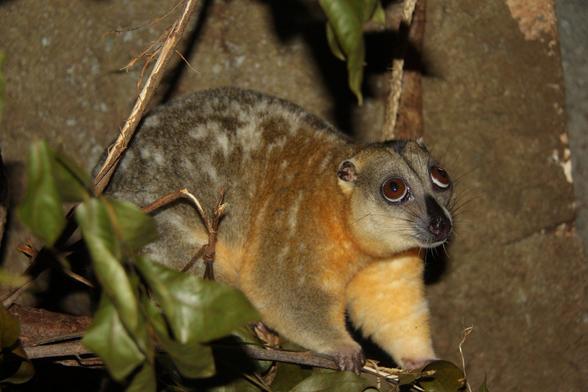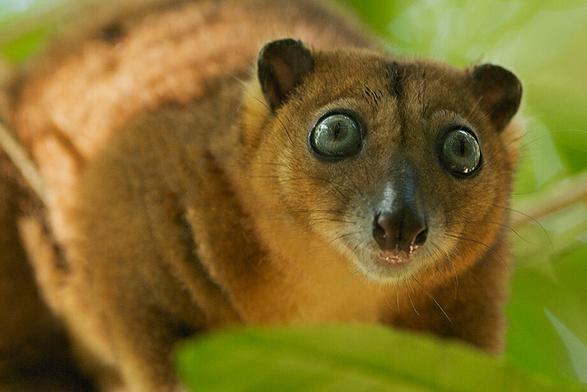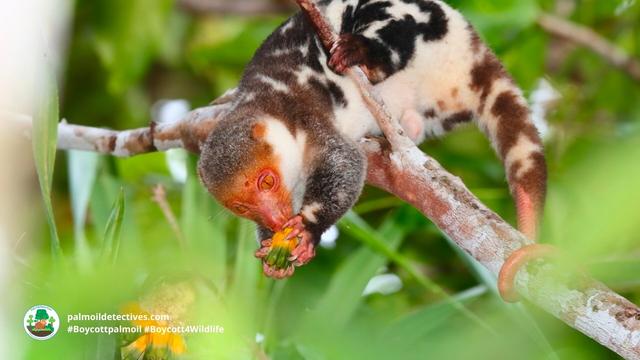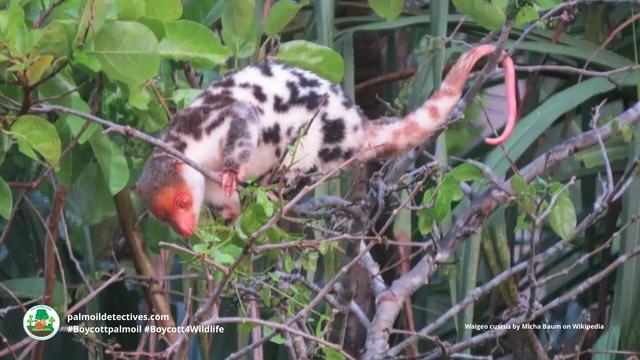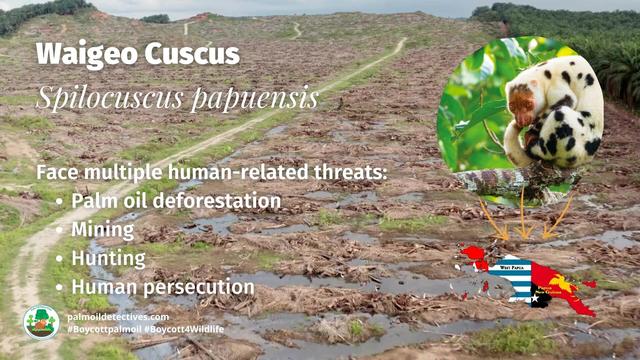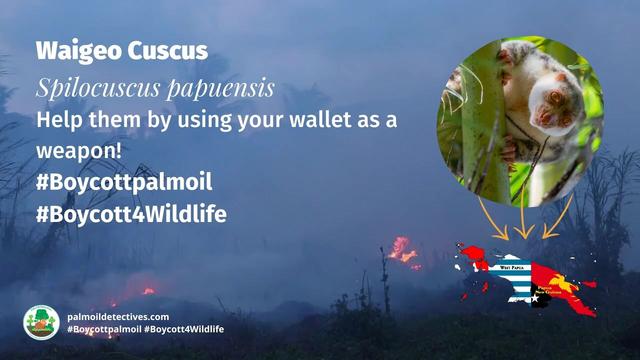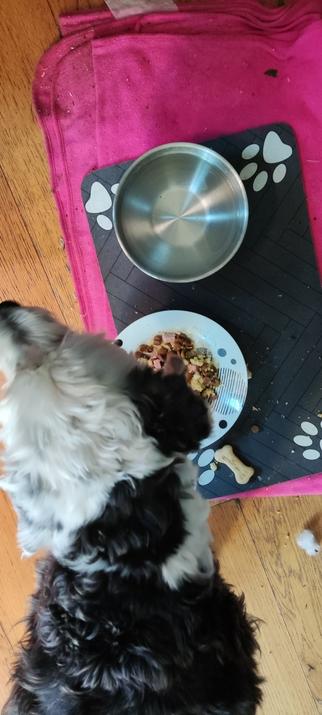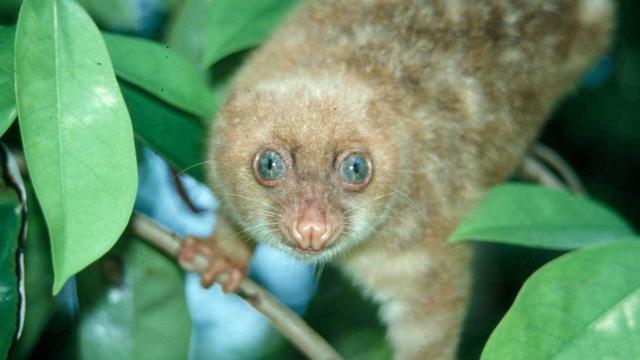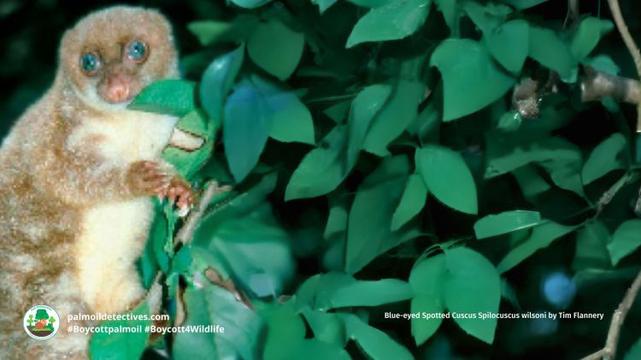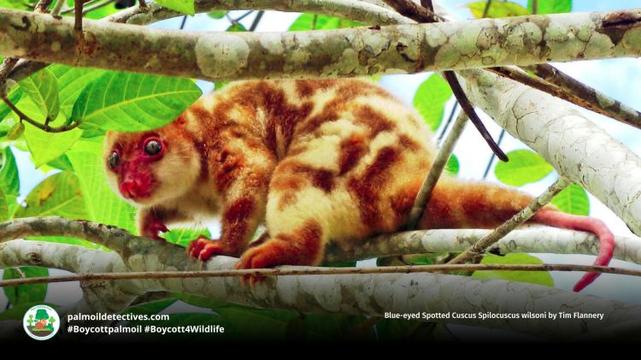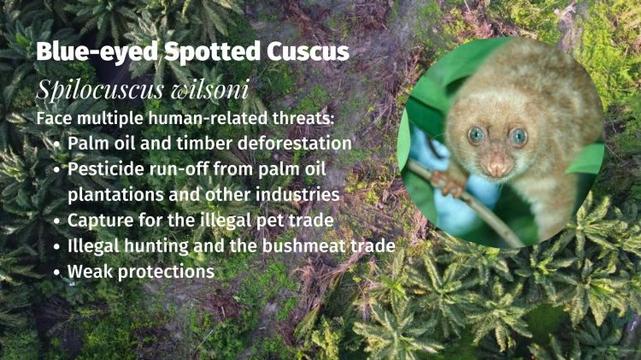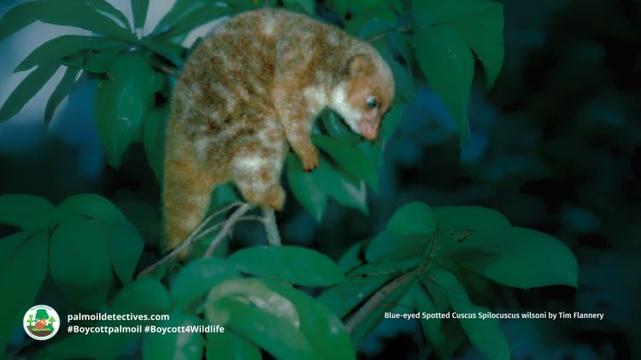Blue-eyed Spotted Cuscus Spilocuscus wilsoni
Blue-eyed Spotted Cuscus Spilocuscus wilsoni
IUCN Red List Status: Critically Endangered
Location: Indonesia – Biak Island, Supiori Island, Numfor Island (Cenderawasih Bay, Indonesian-occupied West Papua)
The blue-eyed spotted #cuscus Spilocuscus wilsoni, also known as the Biak spotted cuscus lives in the lowland tropical rainforests on remote and rugged islands in Cenderawasih Bay: Biak Island, Supiori Island, Numfor Island (Cenderawasih Bay, Indonesian-occupied #WestPapua). These sweet-natured icy-blue eyed #marsupials are Critically Endangered due to a range of threats. They face ongoing population collapse, driven by #palmoil and #timber #deforestation, #hunting, and capture for the illegal exotic #pettrade. Most sightings today are of captive individuals, with wild populations potentially already extirpated from much of their historic range. Time is rapidly running out to save these the last remaining Spilocuscus wilsoni individuals. Use your wallet as a weapon in the supermarket and always choose products that are 100% #palmoilfree.#BoycottPalmOil #Boycott4Wildlife and adopt a #Vegan lifestyle.
https://youtu.be/iEkIXKaynKI
With icy-blue eyes, fluffy fur and gentle demeanour, Blue-eyed Spotted #Cuscus are treasures of #WestPapua now critically #endangered due to #palmoil #deforestation and rampant hunting. Help them survive when you #BoycottPalmOil 🌴🩸❌#Boycott4Wildlife https://palmoildetectives.com/2021/01/26/blue-eyed-spotted-cuscus-spilocuscus-wilsoni/
Share to BlueSky Share to Twitter Living on Biak and Supiori islands #WestPapua, Blue-Eyed Spotted #cuscus are critically endangered😿 The islands are being destroyed for #palmoil and other #agriculture. Take action for #marsupials when you shop #BoycottPalmOil 🌴🚜💀🔥⛔️ #Boycott4Wildlife https://palmoildetectives.com/2021/01/26/blue-eyed-spotted-cuscus-spilocuscus-wilsoni/
Share to BlueSky Share to Twitter Appearance and Behaviour
The blue-eyed spotted cuscus is a mesmerising animal, distinguished by its striking pale blue eyes—an extremely rare trait among marsupials. They have a marbled coat patterned in shades of brown, grey, white, and cream, which varies by age and sex. Males typically exhibit more prominent blotches and spots, while juvenile females may appear spotless and pale yellow or creamy. This species lives high in the rainforest canopy, moving slowly and cautiously among the branches. As a member of the genus Spilocuscus, they are shy, solitary, and largely nocturnal, relying on camouflage and stillness to evade predators.
Diet
Like other spotted cuscus species, the blue-eyed spotted cuscus feeds on a variety of plant matter. Their diet includes leaves, fruits, flowers, and possibly bark. Foraging mostly takes place at night, using their strong limbs and prehensile tail to navigate the treetops in search of food.
Reproduction and Mating
Little is known about the breeding behaviour of the blue-eyed spotted cuscus due to their rarity in the wild. As marsupials, females likely give birth to underdeveloped young that complete their development in a pouch. It is presumed that, like related species, they raise one to two offspring at a time, and may breed seasonally depending on food availability.
Geographic Range
This cuscus species is endemic to the islands of Biak and Supiori in Cenderawasih Bay, with a few individuals reported from Numfor Island, where they may have been introduced as pets. Once more widespread, they are now rarely encountered outside of captivity. The rugged terrain of Supiori has helped protect some of their habitat, but populations on Biak have been decimated by deforestation and human encroachment.
Threats
The Blue-eyed Spotted Cuscus is listed as Critically Endangered because of a continuing drastic population decline, inferred to be more than 80% from the rate and extent of habitat loss in the last 10 years due to massive deforestation on Biak-Supiori and from levels of exploitation. This species is threatened by rapid, ongoing deforestation of suitable habitat, and by hunting for food and collection as a pets by local people.
- Deforestation: Rapid loss of lowland tropical rainforest on Biak and Supiori for palm oil agriculture and development
- Palm oil expansion: Destruction of forest for palm oil plantations threatens remaining habitat
- Hunting: Locals hunt cuscuses for meat
- Illegal pet trade: Capturing and selling them as exotic pets is a major threat
- Lack of enforcement: No targeted conservation programs exist for this species
Take Action!
The blue-eyed spotted cuscus could vanish forever without intervention. Support indigenous-led conservation in West Papua and pressure companies and governments to stop fuelling habitat destruction. Always choose palm oil-free products, and never support the exotic pet trade. Speak up, share their story, and push for their protection. #BoycottPalmOil #Boycott4Wildlife #Vegan #BoycottMeat
FAQs
How many blue-eyed spotted cuscuses are left?
There are no exact population estimates, but the IUCN (2021) infers a population decline of over 80% in the last decade, with wild individuals now rarely seen. Most sightings are of pets or museum specimens, and recent field surveys have failed to find any wild individuals on Biak (IUCN, 2021).
How long do blue-eyed spotted cuscuses live?
Lifespan data for this species is lacking. However, similar species of cuscus in captivity can live 10–15 years, though wild lifespans are likely shorter due to threats from hunting and habitat loss.
Are blue-eyed spotted cuscuses endangered because of palm oil?
Yes. Palm oil deforestation is a major driver of habitat loss in their range. The rapid clearing of lowland rainforest on Biak and Supiori has destroyed much of their habitat. This, combined with hunting and the pet trade, has pushed them to the brink (IUCN, 2021).
Do blue-eyed spotted cuscuses make good pets?
No. Keeping blue-eyed spotted cuscuses as pets is cruel and contributes directly to their extinction. These gentle, tree-dwelling marsupials belong in the rainforest. Many animals in the pet trade are stolen from the wild, causing immense suffering and breaking apart family groups. If you truly care about them, never support the exotic pet trade and advocate against it.
What are the conservation challenges for this species?
The blue-eyed spotted cuscus suffers from neglect in conservation priorities. There are no species-specific conservation efforts, and only a small portion of its range is protected. Further studies into their distribution and natural history are urgently needed to inform protection strategies (Yohanita et al., 2023).
Further Information
Aplin, K. & Helgen, K. 2016. Spilocuscus wilsoni. The IUCN Red List of Threatened Species 2016: e.T136443A21950078. https://dx.doi.org/10.2305/IUCN.UK.2016-2.RLTS.T136443A21950078.en. Downloaded on 26 January 2021.
Wikipedia contributors. (n.d.). Blue-eyed spotted cuscus. Wikipedia. Retrieved 18 April 2025, from https://en.wikipedia.org/wiki/Blue-eyed_spotted_cuscus
Yohanita, A. M., Widayati, K. A., Atmowidi, T., Imai, H., & Suryobroto, B. (2023). New localities and sexual dichromatism in Blue-green eyed Spotted Cuscus Spilocuscus wilsoni from Biak Island, Indonesia. Journal of Threatened Taxa, 15(9), 23836–23842. https://doi.org/10.11609/jott.8179.15.9.23836-23842
Blue-eyed Spotted Cuscus Spilocuscus wilsoni
How can I help the #Boycott4Wildlife?
Take Action in Five Ways
1. Join the #Boycott4Wildlife on social media and subscribe to stay in the loop: Share posts from this website to your own network on Twitter, Mastadon, Instagram, Facebook and Youtube using the hashtags #Boycottpalmoil #Boycott4Wildlife.
Enter your email address
Sign Up
Join 1,391 other subscribers
2. Contribute stories: Academics, conservationists, scientists, indigenous rights advocates and animal rights advocates working to expose the corruption of the palm oil industry or to save animals can contribute stories to the website.
Wildlife Artist Juanchi Pérez
Read more
Mel Lumby: Dedicated Devotee to Borneo’s Living Beings
Read more
Anthropologist and Author Dr Sophie Chao
Read more
Health Physician Dr Evan Allen
Read more
The World’s Most Loved Cup: A Social, Ethical & Environmental History of Coffee by Aviary Doert
Read more
How do we stop the world’s ecosystems from going into a death spiral? A #SteadyState Economy
Read more
3. Supermarket sleuthing: Next time you’re in the supermarket, take photos of products containing palm oil. Share these to social media along with the hashtags to call out the greenwashing and ecocide of the brands who use palm oil. You can also take photos of palm oil free products and congratulate brands when they go palm oil free.
https://twitter.com/CuriousApe4/status/1526136783557529600?s=20
https://twitter.com/PhillDixon1/status/1749010345555788144?s=20
https://twitter.com/mugabe139/status/1678027567977078784?s=20
4. Take to the streets: Get in touch with Palm Oil Detectives to find out more.
5. Donate: Make a one-off or monthly donation to Palm Oil Detectives as a way of saying thank you and to help pay for ongoing running costs of the website and social media campaigns. Donate here
Pledge your support #Agriculture #BlueEyedSpottedCuscusSpilocuscusWilsoni #Boycott4wildlife #Boycott4WildlifeTweet #BoycottMeat #BoycottPalmOil #CriticallyEndangeredSpecies #cuscus #cuscuses #deforestation #endangered #ForgottenAnimals #hunting #Indonesia #Mammal #Marsupial #marsupials #palmoil #palmoilfree #PapuaNewGuineaSpeciesEndangeredByPalmOilDeforestation #pettrade #possum #possums #timber #vegan #WestPapua
